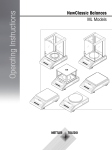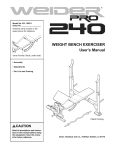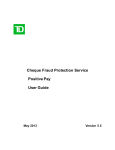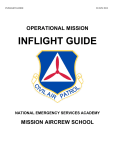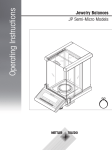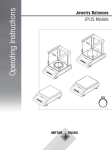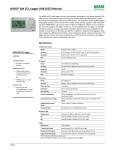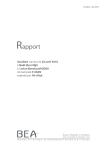Download airports authority of india fire order – 07 basic radiotelephony
Transcript
1 AIRPORTS AUTHORITY OF INDIA FIRE ORDER – 07 [Year of Revision: 2010] BASIC RADIOTELEPHONY PROCEDURE & PHRASEOLOGY 2 AMENDEMENTS From time to time amendments will be issued to this FIRE ORDER No.7. To maintain a correct and up to date copy of the Fire Order it is important that instructions given in amendment notices are carried out. Amendment No. 1 2 3 4 5 6 7 8 9 10 11 Date Amended By whom amended 3 CONTENTS Sr. No. 1 2 3 4 5 6 7 Contents Foreword Transmitting Technique Standards Words and Phrases Establishment and Continuation of Communication Instructions a. Movement instructions b. Final Approach Landing c. Aerodrome Control Vehicle d. Crossing Runway e. Traffic Information Communication Requirement and Visual Signals Test Procedure Page 4 4 5 7 9 12 13 4 1. FOREWORD The efficiency of a rescue and fire fighting service is significantly dependent on the reliability and effectiveness of its communication and alarm system. ICAO recommends that discrete communication system should be provided linking a fire station with the control tower, any other fire station on the aerodrome and the rescue and fire fighting vehicle. Radiotelephony (RTF) provides the means by which pilots and ground personnel communicate with each other, use of non-standard RTF procedure and phraseology can cause misunderstanding. Incidents and accidents have occurred in which a contributing factor has been the misunderstanding caused by the use of poor phraseology. Correct phraseology and procedure a high standard of aeronautical radiotelephony which will contribute to the safety of operations. 2. TRANSMITTING TECHNIQUE 2.1 The following transmitting techniques will assist in ensuring that transmitted speech is clear and satisfactorily received: a. Before transmitting, listen out on the frequency to be used to ensure that there will be no interference with a transmission from another station. b. Be familiar with good microphone operating techniques; c. Use a normal conversational tone, and speak clearly and distinctly; d. Maintain an even rate of speech not exceeding 100 words per minute. When it is known that elements of the message will be written down by the recipient, speak at a slightly slower rate; e. Maintain the speaking volume at a constant level; f. A slight pause before and after numbers will assist in making them easier to understand; g. Avoid using hesitation sounds such as “er”; h. Be familiar with the microphone operating techniques. i. Suspend speech temporally if it becomes necessary to turn the head away from the microphone; j. Depress the transmit switch fully before speaking and do not release it until the message is completed. This will ensure that the entire message is transmitted; k. The transmission of long messages should be interrupted momentarily from time to time to permit the transmitting operator to confirm that the frequency in use is clear and, if necessary, to permit the receiving operator to request repetition of parts not received. l. Microphone position near the mouth should be changed and correct distances should be maintained all the time. Change of position of mouth can result in over modulation and consequent distortion if it brought too close to the mouth 5 3.2 An irritating and potentially dangerous situation in radiotelephony is a “stuck” microphone button. Operators should always ensure that the button in released after a transmission and the microphone placed in an appropriate place ensuring that it will not inadvertently be switched on. 3. STANDARD WORDS AND PHRASES The following words and phrases shall be used in radiotelephony communications as appropriate and shall have the meaning given below. “Prowords” are used to keep transmission clear and brief. Proword / Phrase Meaning ACKNOWLEDGE Instruction to a station to acknowledge that it has heard a message AFFIRM Yes or Correct or I agree APPROVED Permission for proposed action granted BREAK I hereby indicate the separation between portions of the message BREAK BREAK I hereby indicate the separation between messages transmitted to different aircraft in a very busy environment. CANCEL Ignore my previous message. Cancel a message or part of a message or transmission CHECK Examine a system or procedure CLEARED Authorized to proceed under the conditions specified CONFIRM Confirm message or portion indicated CORRECT You are correct or what you have transmitted is correct CORRECTION an error has been made in transmission. The correct version follows. DISREGARD Ignore the last transmission or specified part HOW DO YOU READ What is the readability of my transmission? E.T.A. Estimated time of arrival E.T.D. Expected time of departure GRID REF Used before every group of grid references I SAY AGAIN I repeat for clarity or emphasis I SPELL Used when spelling out a word LONG MESSAGE I am about to relay a message, are you ready to receive it MAINTAIN continue in accordance with the conditions specified or in its literal sense NEGATIVE No or That is incorrect or Permission not granted OUT This exchange of transmission is ended and no response is expected OVER This is the end of my transmission to you and a reply is expected. READ BACK Repeat this entire transmission back to me exactly as you received it. RECLEARED A change has been made to your last clearance and this new clearance supersedes 6 your previous clearance or part thereof ROGER I have received your last transmission satisfactorily. SAY AGAIN Say again all or portion indicated of your last transmission STAND BY I am not ready to receive your transmission or I will call again shortly SEND I am ready to receive your message. URGENT MESSAGE I have a message requiring priority but I am not in any personal danger. UNABLE I cannot comply with your request, instruction or clearance WILCO Your last message (or message indicated) is understood and will be complied with. WORDS TWICE Communication is difficult. Transmit (or I am transmitting) each phrase twice. (May be used as an order, request or for information purposes). WRONG What you have said is wrong. Correct version is ............ VEHICLE MOVEMENT PROWORDS MOBILE On way to incident ARRIVED Arrived at incident IN SERVICE Able to respond to another incident if required RETURNING Returning from an incident STATIONED Returned to station OUT IN AREA Vehicle on radio contact in own brigade area Note:- The phrase “GO AHEAD” has been deleted, in its place the use of the calling aeronautical station’s call sign followed by the answering aeronautical station’s call sign shall be considered the invitation to proceed with transmission by the station calling. 4. TRANSMISSION OF LETTERS To expedite communications, the use of phonetic spelling should be dispensed with if there is no risk of this affecting correct reception and intelligibility of the message. With the exception of the telephony designator and the type of aircraft, each letter in the aircraft call sign shall be spoken separately using the phonetic spelling. The words in the table below shall be used when using the phonetic spelling. Note:- Syllables to be emphasized are underlined Letter A B C D E F G H I J Word Alpha Bravo Charlie Delta Echo Foxtrot Golf Hotel India Juliet Spoken as AL FAH BRAH-VOH CHAR LEE DELL TAH ECK OH FOKS TROT GOLF HO TELL IN DEE AH JUE LEE ETT 7 K L M N O P Q R S T U V W X Y Z Kilo Lima Mike November Oscar Papa Quebec Romeo Sierra Tango Uniform Victor Whiskey X-ray Yankee Zulu KEY LOH LEE MAH MIKE NO VEM BER OSS CAH PAH PAH KEH BECK ROW ME OH SEE AIR RAH TANG GO YOU NEE FORM VIK TAH WISS KEY ECKS RAY YANK KEY ZOO LOO 5. TRANSMISSION OF NUMBERS 5.1 When the language used for communication is English, numbers shall be transmitted using the following pronunciation. Note:- The syllables printed in capital letters are to be stressed; for example, the two syllables in ZE-RO are given equal emphasis, whereas the first syllable of FOW-er is given primary emphasis Numeral or numeral element Pronunciation 0 ZE -RO 1 WUN 2 TOO 3 TREE 4 FOW-er 5 FIFE 6 SIX 7 SEV-en 8 AIT 9 NIN-er Decimal DAY-SEE-MAL Hundred HUN-dred Thousand TOU-SAND 5.2 All numbers except as specified in 5.3; shall be transmitted by pronouncing each digit separately. Aircraft call signs AIC 238 VT- JSL Transmitted as Air India two three eight Victor Tango Juliet Sierra Lima Flight levels FL 180 Transmitted as Flight level one eight zero 8 FL 200 Flight level two zero zero Headings 100 degrees 080 degrees Transmitted as heading one zero zero heading zero eight zero Wind direction and speed 200 degrees 70 knots Transmitted as wind two zero zero degrees seven zero knots Transponder codes 2 400 4 203 Transmitted as squawk two four zero zero squawk four two zero three Runway 27 30 Transmitted as runway two seven runways three zero 5.3All numbers used in the transmission of altitude, cloud height, visibility and runway visual range (RVR) information, which contain whole hundreds and whole thousands, shall be transmitted by the word HUNDRED or THOUSAND as appropriate. Altitute 800 3 400 12 000 Transmitted as eight hundred three thousand four hundred one two thousand Cloud height 2 200 4 300 Transmitted as two thousand two hundred four thousand three hundred Visibility 1000 700 Transmitted as visibility one thousand visibility seven hundred Runway visual range 600 1 700 Transmitted as RVR six hundred RVR one thousand seven hundred Channel 118,000 118.005 118.025 118.100 Transmitted as ONE ONE EIGHT DECIMAL ZERO ONE ONE EIGHT DECIMAL ZERO ZERO FIVE ONE ONE EIGHT DECIMAL ZERO TWO FIVE ONE ONE EIGHT DECIMAL ONE 5.4 While runway inspection when it is felt that the information may prove useful to tower / aircraft or whenever a controller deems it necessary, information that water is on a runway shall be passed to aircraft using the terms :DAMP:, “WET”, “WATER”, “PATCHES” or “FLOODED” according to the amount of water present. 9 6. TRANSMISSION OF TIME When transmitting time, only the minutes of the hour should normally be required. Each digit should be pronounced separately. However, the hour should be included when any possibility of confusion is likely to result. The following example illustrates; Time 0920 (9:20 A.M) 1643 (4:43 P.M) Transmitted as ZE-RO NIN- er TOO ZE-RO WUN SIX FOW- er TREE 7. ESTABLISHMENT AND CONTINUATION OF COMMUNICATION If there is doubt that a message has been correctly received, a repetition of the message shall be requested either in full or in part. Phrase SAY AGAIN SAY AGAIN ... (item) SAY AGAIN ALL BEFORE (the first word satisfactorily received ) SAY AGAIN ALL AFTER.... (the last word satisfactorily received) Meaning Repeat entire message Repeat specific item Repeat part of message Repeat part of message Example: From TWR To F/S F/S TWR F/S SAY AGAIN ALL BETWEEN ...AND... TWR F/S TWR Message Full emergency, Indian Airlines B737 Heavy smoke in cargo hold, persons on board 69, endurance 0130 landing rwy ... within 6 minutes Say again POB and endurance only POB 69, endurance 0130 Rogar Repeat part of message. When an error is made in transmission the word “CORRECTION” shall be spoken, the last correct group or phrase repeated and then the correct version transmitted. If a correction can best be made by repeating the entire message; the operator shall use the phrase “CORRECTION I SAY AGAIN” before transmitting the message a second time. 8. INSTRUCTIONS 8a. Movement Instructions Drivers on first call should identify themselves by their vehicle call sign, state their position and intended destination (and possibly required route) Example: Tower - CFT 1 - present position fire station, request proceed to taxiway HOTEL to attend a fire call. 10 CFT 1 – Tower- Proceed to taxiway Hotel via Kilo and Alpha The controller, if too busy to give instructions, will reply “standby” or “wait”. This means that the driver should wait until the controller calls back. The driver shall not proceed until permission is given. When there is conflicting traffic the controller may reply “HOLD POSITION”. This means that the driver shall not proceed until the controller calls back with permission. All other replies should contain clearly defined point to which the driver may proceed; this may or knot be the intended destination. If it is not the intended destination drivers must stop at this point and request permission before proceeding further. Example, Tower—CFT Request proceed to hanger 3 CFT – Tower Proceed via Kilo Alpha cross Runway 09 hold short of Runway 14. Tower – CFT Via kilo alpha cross 09 hold short of Runway 14. CFT – Tower Cross Runway 14 continue to hangar 3 Tower – CFT crossing Tower – CFT Runway 14 vacated. CFT – Tower ROGER. Permission to proceed on the apron may include such instructions regarding other traffic as are thought necessary to safe operations. 8b. Final Approach and Landing An aircraft reports “FINAL “when it turns onto final within 7 km (4 nm) from touchdown. If and when the turn onto final is made at a greater distance, a ‘LONG FINAL’ report is made. If the aircraft is making a straight in approach a long final report is made at about 15 km (8 nm) from touchdown. 8c. Aerodrome Control Vehicles The expeditious movement of vehicles plays an essential supporting role in the operation of an aerodrome. Wherever possible the areas in which vehicles and aircraft operate are segregated. However, there are many occasions when vehicles need to move on the manoeuvring area for maintenance purposes or it direct support of aircraft operations. Procedures governing the movement of vehicles vary widely from aerodrome to aerodrome, but certain factors to be taken into account when driving on an aerodrome are common to all: a. In general aircraft are by no means as manoeuvrable as ground vehicles. b. The visibility from an aircraft cockpit for ground movement purposes is often restricted compared to that from a ground vehicle. c. Therefore, when vehicles are operating in close proximity to aircraft, drivers should be extremely vigilant and comply in full with local procedures and ATC instructions. 11 d. Correct RTF operating technique must be observed by all users. It is important that a continuous listening watch is maintained by all vehicles on the movement area, not only in case of further instructions from the control tower, but also so that drivers can be aware of the movements and intended movements of other traffic, thereby reducing the risk of confliction. 8d. Crossing Runway Drivers should note carefully the position to which they may proceed, particularly where the intended route involves crossing a runway. Some aerodromes may gave procedures that will allow vehicles to proceed to a holding point on the movement area and then request runway – crossing instructions. Under no circumstances shall a driver cross a runway unless positive permission has been given and acknowledged. A runway – vacated report shall not be made until the vehicle is clear of the designated runway area. Example, Tower CFT Request proceed to maintenance base. CFT Tower Proceed via India and bravo hold short of Runway 27. Tower CFT Via India and bravo hold short of runway 27. Tower CFT Holding short runway 27. CFT Tower Cross-runway 27 to taxiway mike report vacated runway. Tower CFT Crossing runway 27. Tower CFT Runway vacated. Tower Continue on mike to maintenance. CFT If a vehicle is operating on the runway it shall be instructed to leave the runway when it is expected that an aircraft will be landing or taking off CFT Tower Vacate runway 27, take next right, report vacated. Tower CFT WILCO Tower CFT Runway 27 vacated CFT ROGER Tower When vehicle is moving on the movement area it may be necessary to inform the vehicle of a potentially dangerous situation and to instruct it to stop. CFT Tower Tower CFT Stop immediately Stopping 12 8e. Traffic Information To pass traffic information from ATC to Fire Watch Tower/ Fire Station: Example: Traffic Indian Airlines Airbus 320 (three two – zero) long final Runway 28 To acknowledge from fire station/fire watch tower: Example: Traffic insight or looking out 9. COMMUNICATION REQUIREMENTS AND VISUAL SIGNALS 9.1 At aerodromes all vehicles employed on the manoeuvring area shall be capable of maintaining two way radio communications with the aerodrome control tower, except when the vehicle is only occasionally used on the manoeuvring area and is: i. ii. Accompanied by a vehicle with the required communications capability or Employed in accordance with a pre- arranged plan established with the aerodrome control tower. 9.2 When communications by a system of visual signals is deemed to be adequate or in the case of radio communication failure, the signals given hereunder shall have the meaning indicated therein: Light signal from aerodrome control Green flashes Steady red Red flashes White flashes Meaning Permission to cross landing area or to move onto taxiway Stop Move off the landing area or taxiway and watch out for aircraft Vacate manoeuvring area in accordance with local instructions. 9.3 In emergency conditions or if the signals in previous para are not observe, the signal given hereunder shall be used for runways or taxiways equipped with a lighting system and shall have the meaning indicated therein. Light signal Flashing runway or taxiway lights Meaning Vacate the runway and observe the tower for light signal. 13 10. TEST PROCEDURE On the air radio tests when necessary should be short (not more than 10 seconds) do not interfere with other communications. i. Test transmission should take the following form: a) The identification of the aeronautical station being called b) The aircraft identification c) The words “RADIO CHECK ” and d) The frequency being used ii. Replies to test transmission should be as follows a) The identification of the station calling b) The identification of the station replying c) Information regarding the readability of the transmission. The readability of transmission should be classified in accordance with the following readability scale. iii. REDABILITY PROWORDS Readability Strength Unreadable 1 Reading Intermittently 2 Readable with difficulty 3 Readable 4 Perfectly Readable 5 References: The following ICAO documents have been referred for preparation of Fire Order No. – 7. a) DOC 9432 – AM/925 – Manual of Radiotelephony b) DOC 4444 – Air Traffic Management c) DOC 9137 – Airport Service Manual Part – 1. (JYOTI PRASAD) EXECUTIVE DIRECTOR - ATM













